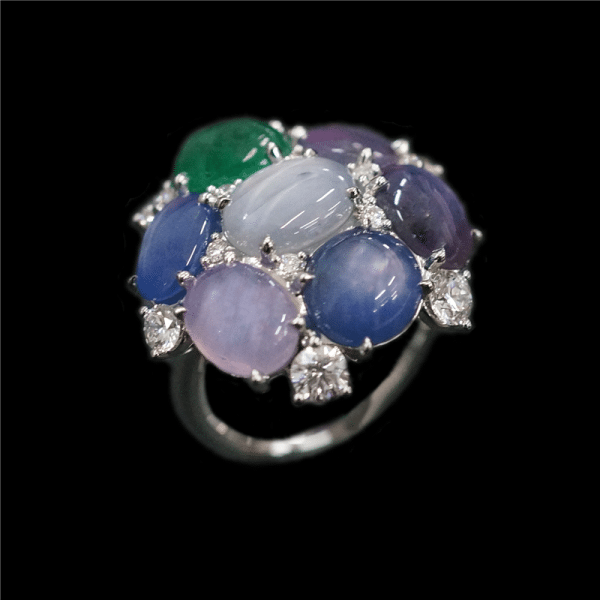By Isabelle Corvin, CG, Staff Gemologist at Panowicz Jewelers
One could argue that all gemstones are phenomenal; after all, what else on our planet is as beautiful and intriguing as a jewel?
But true “phenomenal” stones are those gems that go above and beyond with unique and stunning attributes. Opals with play-of-color, alexandrites with color-changing abilities and cat’s-eye gems displaying chatoyancy (an optical reflectance effect), to name a few.
In terms of magical presence, however, star stones might be the winners in the phenomenal category. Star stones are gemstones that display a unique pattern called asterism.
What is asterism?
Asterism is the term given to gemstones that display a “star” pattern. These star stones are almost always cut as cabochons, so the effect can be readily seen. The star can have four, six, eight or even twelve rays.

Asterism is caused by microscopic, intersecting needle inclusions, the most common of which are rutile. These needles must be oriented at just the right angles to produce a star pattern when light enters the stone and then reflects off the inclusions.
As you can imagine, a star stone offers an effect that is rare and absolutely enchanting.
Which gems display asterism?
Star stones can be sapphires and rubies, as well as rose quartz, spinel and garnet. A few other extremely rare minerals have also been found with occasional asterism.
Star stone sapphires are the most well-known of the bunch, with the most famous likely being the Star of India, a 563.35ct star sapphire that many estimate to be approximately two billion years old.
Where did the term “asterism” originate?
Asterism comes from the Greek root word of asterismos, believed to mean “marking with stars.” The most common use of the word “asterism” is in astronomy, referring to a group of stars that are smaller than a constellation. In fact, the Big Dipper is actually an asterism, as it’s part of the larger constellation Ursa Major (the Great Bear).
How rare is asterism in jewels?
Even now, with our understanding of how these star stones’ patterns form, the chance that the inclusions are the right kind, in the right place, at the right angles, makes this phenomenon rare when naturally occurring.
Laboratory-grown versions of star stones, especially ruby and sapphire, are common and can mimic the effect perfectly. While not as rare as the natural varieties, they are lovely and still showcase that incredibly unique pattern.
What are some myths and stories about asterism?
With such an unusual and magical appearance, it’s no wonder star stone myths can be found here and there. Some of the oldest stories come from Ceylon, where star sapphires were believed to be wards against witchcraft, hexes and curses, and a guard against the “evil eye.” Star stones are believed to have more energy than the “normal” versions of each gem, making any healing abilities associated with them more powerful.
Other tales speak of how a star stone could act as a compass, not only for finding north but also in a more whimsical sense of finding direction in life. This belief of star stones being a guiding stone persists today in modern crystal symbolism.
In the early Catholic church, the intersecting bands of six-rayed stars were said to represent faith, hope and charity. Arab legend states that the star sapphire would give the wearer the ability to speak and understand the language of the Genii (plural form of genie).
Some stories even claim that part of Helen of Troy’s charm and beauty was due to her supposedly owning a large star sapphire.
Asterisms are beautiful inclusions
Star stones are the perfect showcase of why inclusions aren’t always a detriment to a jewel’s beauty. In fact, they can enhance it.
That gemstones and jewelry found on Earth can mirror the stars above is one more reason they fascinate and entice us.
If you know someone looking for a little magic in their life, a star stone might be the perfect gift. To purchase a star stone, start by finding a credentialed American Gem Society (AGS) jeweler. Simply use our easy Find a Jeweler search function that allows you to find AGS jewelers near you.
Isabelle Corvin is an AGS Certified Gemologist (CG) who is the Staff Gemologist at Panowicz Jewelers. Since she was 14, she knew she wanted to be a gemologist. Ms. Corvin also writes for Panowicz Jewelers’ blog.